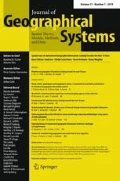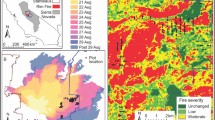Abstract
Wildfires are frequent boreal forest disturbances in Canada, and emulating their patterns with forest harvesting has emerged as a common forest management goal. Wildfires contain many patches of residual vegetation of various size, shape, and composition; understanding their characteristics provides insights for improved emulation criteria. We studied the occurrence of residual vegetation within eleven boreal wildfire events in a natural setting; fires ignited by lightning, no suppression efforts, and no prior anthropogenic disturbances. Relative importance of the measurable geo-environmental factors and their marginal effects on residual presence are studied using Random Forests. These factors included distance from natural firebreaks (wetland, bedrock and non-vegetated areas, and water), land cover, and topographic variables (elevation, slope, and ruggedness index). We present results at spatial resolutions ranging from four to 64 m while emphasizing four and 32 m since they mimic IKONOS- and Landsat-type images. Natural firebreak features, especially the proximity to wetlands, are among the most important variables that explain the likelihood residual occurrence. The majority of residual vegetation areas are concentrated within 100 m of wetlands. Topographic variables, typically important in rugged terrain, are less important in explaining the presence of residuals within our study fires.







Similar content being viewed by others
References
Andison DW (2012) The influence of wildfire boundary delineation on our understanding of burning patterns in the Alberta foothills. Can J For Res 42(7):1253–1263
Araya YH, Remmel TK, Perera AH (2015) Residual vegetation patches within natural boreal wildfires: characterizing by pattern metrics, land cover expectations, and proximity to firebreak features. Geomatica 69(4):3237–3338
Arseneault D (2001) Impact of fire behaviour on post-fire forest development in a homogeneous boreal landscape. Can J For Res 31(8):1367–1374
Breiman L (2001) Random forests. J Mach Learn 45(1):5–31
Burton PJ, Parisien M, Hicke J, Hall RJ, Freeburn JT (2008) Large fires as agents of ecological diversity in the North American boreal forest. Int J Wildland Fire 17(6):754–767
Cuesta RM, Garcia M, Retana J (2009) Factors influencing the formation of unburned forest islands within the perimeter of a large forest fire. For Ecol Manag 258(2):71–80
Cullinane-Anthony BL, Seefelt NE, Corace RG, Kashian DM, Gehring TM (2014) Influence of residual forest patches on post-fire bird diversity patterns in jack pine-dominated ecosystems of northern Lower Michigan. For Ecol Manag 331:93–103
Cutler DR, Edwards TC, Beard KH, Cutler A, Hess KT, Gibson J, Lawler JJ (2007) Random forest for classification in ecology. Ecology 88(11):2783–2792
De’ath G, Fabricius K (2000) Classification and regression trees: a powerful yet simple technique for ecological data analysis. J Ecol 81(11):3178–3192
Delong SC, Tanner D (1996) Managing the pattern of forest harvest: lessons from wildfire. Biodivers Conserv 5(10):1191–1205
Dragotescu L, Kneeshaw DD (2012) A comparison of residual forest following fires and harvesting in boreal forests in Quebec, Canada. Silva Fenn 46(3):365–376
Epting J, Verbyla D (2005) Landscape-level interactions of prefire vegetation burn severity, and postfire vegetation over a 16-year period in interior Alaska. Can J For Res 35(6):1367–1377
Evans JE, Cushman SA (2009) Gradient modelling of conifer species using random forests. Landsc Ecol 24(5):673–683
Friedman J (2009) Tutorial: getting started with MART in R. http://www-stat.stanford.edu/~jhf/rmart/tutorial/tutorial.pdf
Genuer R, Poggi J, Tuleau-Malot C (2010) Variable selection using random forests. Pattern Recogn 31(14):2225–2236
Gislason PO, Benedictsson JA, Sveinsson KR (2006) Random forests for land cover classification. Pattern Recogn Lett 27(4):294–300
Guisan A, Zimmerman NE (2000) Predictive habitat distribution models in ecology. Ecol Model 135(2–3):147–186
Hastie T, Tibshirani R, Friedman J (2009) The elements of statistical learning: data mining, inference, and prediction. Springer series in statistics. Springer, Berlin, pp 337–384
Hills GA (1961) The ecological basis for land-use planning. Research report 46, Research Branch, Ontario Department of Lands and Forests, Maple
Iverson LR, Prasad AM, Liaw A (2004) New machine learning tools for predictive vegetation mapping after climate change: bagging and random forest perform better than regression tree analysis. In: Richard S (ed) Landscape ecology of trees and forests: proceedings of the twelfth annual IALE (UK) conference, International Association for Landscape Ecology, Cirencester, pp 317–320
Johnson EA (1995) Fire and vegetation dynamics: studies from the North American boreal forest. Cambridge University Press, Cambridge, pp 22–58
Johnson EA, Miyanishi K, Weir JH (1998) Wildfires in the western Canadian boreal forest: landscape patterns and ecosystem management. J Veg Sci 9(4):603–610
Kafka V, Gauthier S, Bergeron Y (2001) Fire impacts and crowing in the boreal forest: study a large wildfire in western Quebec. Int J Wildland Fire 10:119–127
Liaw A, Wiener M (2002) Classification and regression by Random Forests. R News 2(3):18–22
Madoui A, Leduc A, Gauthier S, Bergeron Y (2009) Spatial pattern analyses of post-fire residual stands in the black spruce boreal forest of western Quebec. Int J Wildland Fire 19(8):1110–1126
Morlon H, Chuyong G, Condit R, Hubbel S, Kenfack D, Valencia R, Green JL (2008) A general framework for the distance-decay of similarity in ecological communities. Ecol Lett 11(9):904–917
Munoz J, Felicisimo AM (2004) Comparison of statistical methods commonly used in predictive modelling. J Veg Sci 15(2):285–292
[OMNR] Ontario Ministry of Natural Resources (2010) Forest management guide for conservation biodiversity at the stand and site scales: background and rationale for direction. Queen’s printer for Ontario, Toronto
[OMNR] Ontario Ministry of Natural Resources (2014) Forest management guide for boreal landscapes. Queen’s printer for Ontario, Toronto
Pearce J, Ferrier S (2000) Evaluating the predictive performance of habitat models developed using logistic regression. Ecol Model 133(3):225–245
Perera AH, Buse LJ (2014) Ecology of wildfire residuals in boreal forests. Wiley Blackwell, Hoboken, pp 18–80
Perera AH, Buse LJ, Weber MG, Crow TR (2004) Emulating natural forest landscape disturbances: a synthesis. In: Perera AH, Buse LJ, Weber MG (eds) Emulating natural forest landscape disturbance: concepts and applications. Columbia University Press, New York, pp 265–282
Perera AH, Dalziel BD, Buse LJ, Routledge RG (2009a) Spatial variability of stand-scale residuals in Ontario’s boreal forest fires. Can J For Res 39(5):945–961
Perera AH, Remmel TK, Buse LJ, Ouellete MR (2009b) An assessment of residual patches in boreal fires, in relation to Ontario’s policy directions for emulating natural forest disturbance. Ontario Ministry of Natural Resources, Ontario Forest Research Institute, Saulte Ste. Marie, Ontario. Forest research report no. 169
Peters J, Baets BD, Verhoest NE, Samson R, Degroeve S, Becker PD, Huybrechts W (2007) Random forests as a tool for ecohydrological distribution modelling. Ecol Model 207(2–4):304–318
Prasad AM, Iverson LR, Liaw A (2006) Newer classification and regression tree techniques: bagging and random forests for ecological prediction. J Ecosyst 9(2):181–199
R Core Team (2014) R: a language and environment for statistical computing. R foundation for statistical computing, Vienna, Austria. http://www.R-project.org/
Remmel TK, Perera AH (2009) Mapping natural phenomena: boreal forest fires with non-discrete boundaries. Cartographica 44(4):274–288
Riley S, DeGloria SD, Elliot R (1999) A terrain ruggedness index that quantifies topographic heterogeneity. Int J Sci 1(4):23–27
Ryan KC (2002) Dynamic interactions between forest structure and fire behaviour in boreal ecosystems. Silva Fenn 36(1):13–39
Schroff F, Criminisi A, Zisserman A (2008) Object class segmentation using random forests. In: Everingham M, Needham C (eds) Proceedings of the 19th British machine vision conference, BMVA Press, Leeds, pp 54.1–54.10
Spectranalysis (2005) IKONOS land cover classification for the assessment of forest burns. Internal report prepared for forest landscape ecology program, Ontario Forest Research Institute, Ministry of Natural Resources
Strobl C, Hothorn T, Zeileis A (2009) Party on! A new, conditional variable importance measure for random forests available in the party package. R J 1(2):14–17
Turner MG, Romme WH, Gardner RH, Hargrove WW (1997) Effects of fire size and pattern on early succession in Yellowstone National Park. Ecol Monogr 67(4):411–433
van Wagtendonk JW (2004) Fire and landscapes: patterns and processes. USDA Forest Service Gen. Technical report, PSW-GTR-193
William JC, Gray PA, Uhling PW, Wester MC (2009) The ecosystems of Ontario, part 1: ecozones and ecoregions. Science and information branch: inventory, monitoring, and assessment section, technical report SIB TER IMA TR-01
Wong DW (2009) The modifiable areal unit problem (MAUP). In: Fotheringham AS, Rogerson PA (eds) The SAGE handbook of spatial analysis. Sage Publications, London, pp 105–122
Wu J (1999) Hierarchy and scaling: extrapolating information along a scaling ladder. Can J Remote Sens 25(4):367–380
Wu J, Shen W, Sun W, Tueller PT (2002) Empirical patterns of the effects of changing scale on landscape metrics. Landsc Ecol 17(8):761–782
Zaniewski AE, Lehmann A, Overton MJ (2002) Predicting species spatial distributions using presence-only data: a case study of native New Zealand ferns. Ecol Model 157(2-3):261–280
Author information
Authors and Affiliations
Corresponding author
Rights and permissions
About this article
Cite this article
Araya, Y.H., Remmel, T.K. & Perera, A.H. What governs the presence of residual vegetation in boreal wildfires?. J Geogr Syst 18, 159–181 (2016). https://doi.org/10.1007/s10109-016-0227-9
Received:
Accepted:
Published:
Issue Date:
DOI: https://doi.org/10.1007/s10109-016-0227-9




